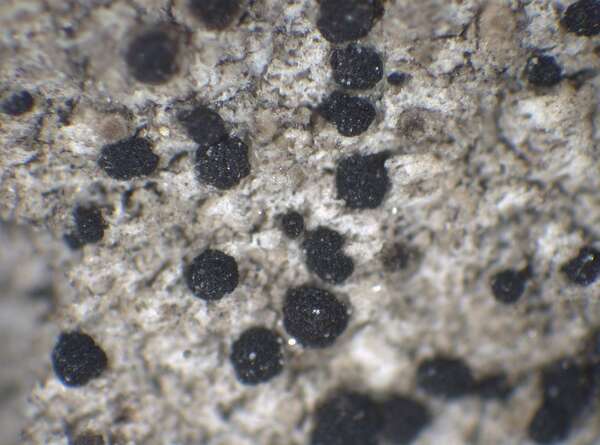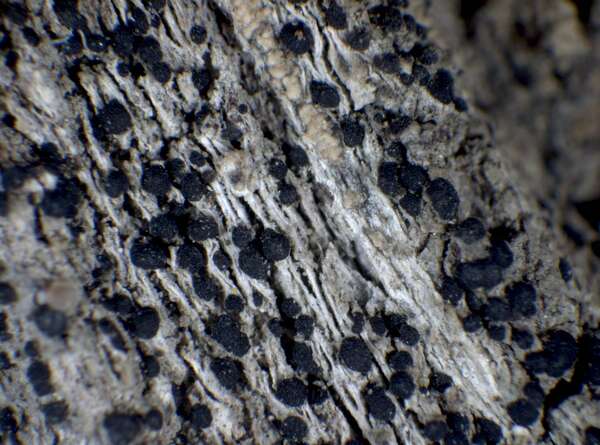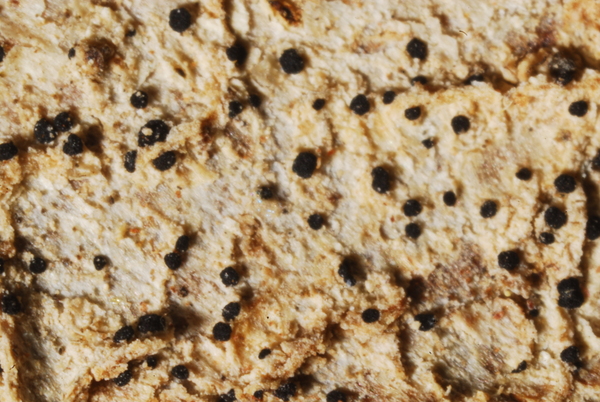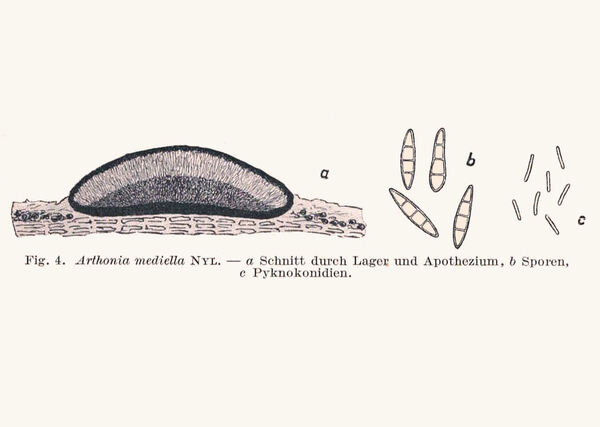Arthonia mediella Nyl.
Not. Sällsk. Fauna Fl. Fenn. Förh., ny ser. 1: 238, 1859.
Synonyms: Arthonia sordaria Körb.
Description: Thallus crustose, thin, continuous to finely rimose, smooth or roughened, grey to yellowish grey. Apothecia arthonioid, black, round to weakly angular, 0.2-0.5 mm across, with a flat to slightly convex, dull, epruinose disc, without a distinct proper margin. Proper exciple poorly evident; epithecium brown-black; hymenium colourless to pale yellow, (30-)40-60 µm high, not inspersed with oil droplets, K-, I+ orange-yellow; paraphysoids strongly coherent, simple or slightly branched, thin, the apical cells capitate, 3-5 µm wide, with a dark brown cap; hypothecium reddish brown in upper part, brown-black in lower part, 30-70 µm high. Asci 8-spored, broadly clavate, semi-fissitunicate, with a large apical dome and a distinct ocular chamber, Arthonia-type. Ascospores 3(-4)-septate, slightly constricted at septa, with subequal cells, hyaline, spindle-shaped, (10-)11-16(-18) x (2.5-)3-4(-5) µm. Pycnidia dark, immersed to sessile, 0.3-0.6 mm across. Conidia bacilliform, 4-6 x c. 1 µm. Photobiont chlorococcoid. Spot tests: thallus K-, C-, KC-, P-, UV-. Chemistry: without lichen substances.
Growth form: Crustose
Substrata: bark
Photobiont: green algae other than Trentepohlia
Reproductive strategy: mainly sexual
Most common in areas with a humid-warm climate (e.g. most of Tyrrenian Italy)
Pioneer species
Commonnes-rarity: (info)
Alpine belt: absent
Subalpine belt: rather rare
Montane belt: very rare
Dry submediterranean belt: absent
Humid submediterranean belt: absent
Padanian area: absent
pH of the substrata:
1 2 3 4 5
Solar irradiation:
1 2 3 4 5
Aridity:
1 2 3 4 5
Eutrophication:
1 2 3 4 5
Poleotolerance:
0 1 2 3
Altitudinal distribution:
1 2 3 4 5 6
Rarity
absent
extremely rare
very rare
rare
rather rare
rather common
common
very common
extremely common
Loading data...
Occurrence data
Predictive map
Growth form: Crustose
Substrata: bark
Photobiont: green algae other than Trentepohlia
Reproductive strategy: mainly sexual
Most common in areas with a humid-warm climate (e.g. most of Tyrrenian Italy)
Pioneer species
Commonnes-rarity: (info)
Alpine belt: absent
Subalpine belt: rather rare
Montane belt: very rare
Dry submediterranean belt: absent
Humid submediterranean belt: absent
Padanian area: absent
pH of the substrata:
| 1 | 2 | 3 | 4 | 5 |
Solar irradiation:
| 1 | 2 | 3 | 4 | 5 |
Aridity:
| 1 | 2 | 3 | 4 | 5 |
Eutrophication:
| 1 | 2 | 3 | 4 | 5 |
Poleotolerance:
| 0 | 1 | 2 | 3 |
Altitudinal distribution:
| 1 | 2 | 3 | 4 | 5 | 6 |
Rarity
absent
extremely rare
very rare
rare
rather rare
rather common
common
very common
extremely common
Loading data...
Occurrence data
Predictive map










